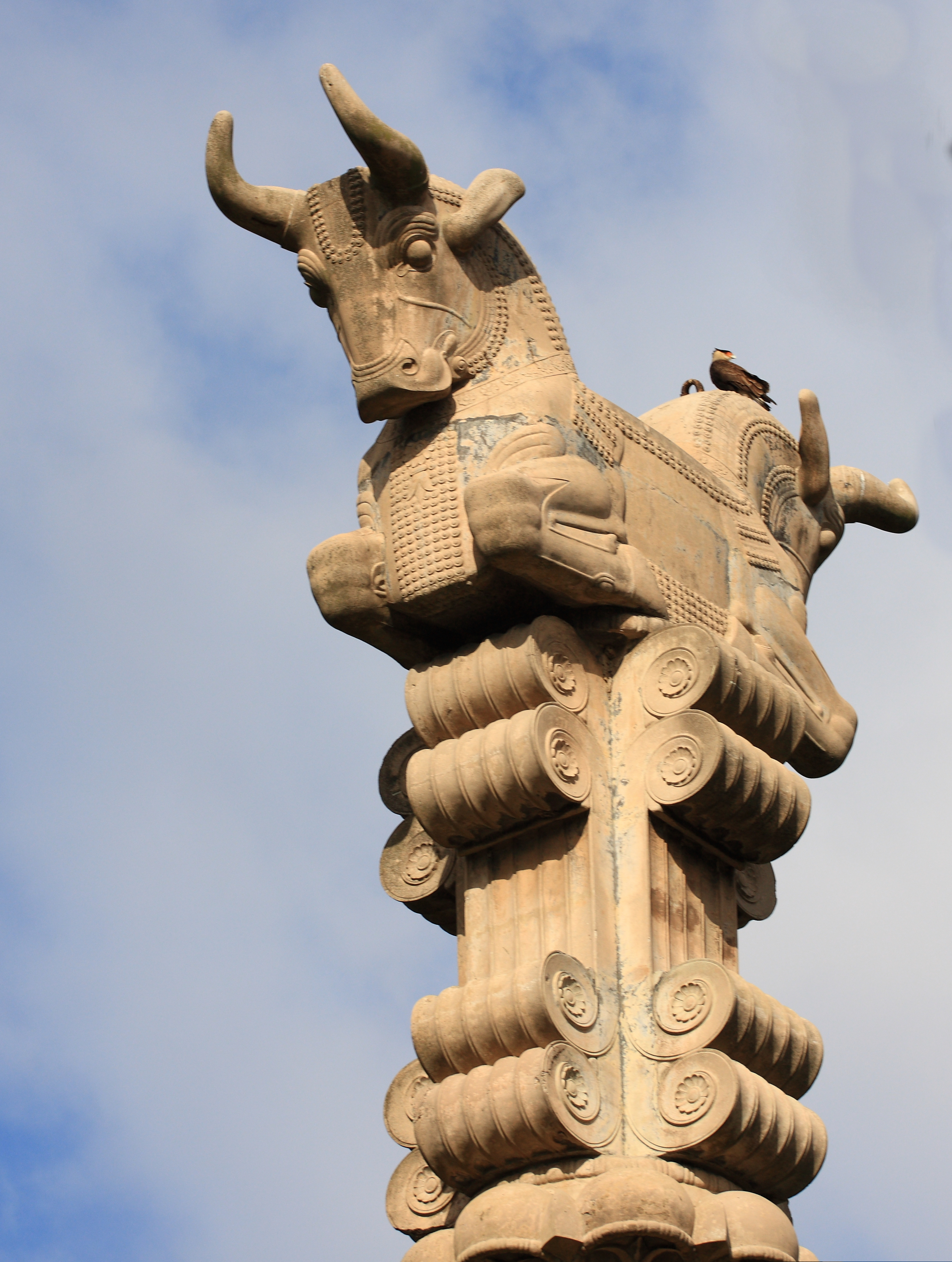|
Protome
A protome ( Greek: προτομή) is a type of adornment that takes the form of the head and upper torso of either a human or an animal. History Protomes were often used to decorate ancient Greek architecture, sculpture, and pottery. Protomes were also used in Persian monuments. At Persepolis (ca. 521-465 BCE), an array of stone fluted Persian columns topped by bull protomes distinguish the great hall (apadana) where the king received guests numbering over 10,000. Protomes, combining several different animals are also found at the palace of Darius I, Susa, Iran. At his palace at Susa, pairs of complex protomes feature animals (mythic or real) known to be fierce or intimidating. These function symbolically and structurally: they symbolize power and cosmic balance, but they also support the beams of the ceiling structure. At Susa, the protome capitals form a socket that holds the roof beams in place. Many Protome are Terracotta mould-made busts of women that were representations ... [...More Info...] [...Related Items...] OR: [Wikipedia] [Google] [Baidu] |
Persian Column
Persian columns or Persepolitan columns are the distinctive form of column developed in the Achaemenid architecture of ancient Persia, probably beginning shortly before 500 BCE. They are mainly known from Persepolis, where the massive main columns have a base, Fluting (architecture), fluted shaft, and a double-animal Capital (architecture), capital, most with bulls. Achaemenid palaces had enormous hypostyle halls called apadana, which were supported inside by several rows of columns. The Throne Hall or "Hall of a Hundred Columns" at Persepolis, measuring 70 × 70 metres was built by the Achaemenid king Artaxerxes I. The apadana hall is even larger. These often included a throne for the king and were used for grand ceremonial assemblies; the largest at Persepolis and Susa could fit ten thousand people at a time. The Achaemenids had little experience of stone architecture, but were able to import artists and craftsmen from around their empire to develop a hybrid imperial style dr ... [...More Info...] [...Related Items...] OR: [Wikipedia] [Google] [Baidu] |
Stephane (Ancient Greece)
A stephane (''ancient Greek'' στέφανος, from ''στέφω'' (stéphō, “I encircle”), ''Latin, Lat.'' Stephanus = wreath, decorative wreath worn on the head; crown) was a decorative headband or circlet made of metal, often seen on depictions of high-status ancient Roman and Greek women, as well as goddesses. The stephane often consisted of a metal arc that was higher in the center than along the sides. It was set atop a woman's hair, with or without a veil. It resembled a crown. Many ancient Greek and Ancient Rome, Roman coins show a queen's portrait on the obverse, with her wearing a veil with a stephane. See also * Clothing in the ancient world **Clothing in ancient Greece * Chiton (costume) * Exomis * Himation * Peplos * Zoster (costume) References {{reflist Headgear ... [...More Info...] [...Related Items...] OR: [Wikipedia] [Google] [Baidu] |
British School At Athens
The British School at Athens (BSA; ) is an institute for advanced research, one of the eight British International Research Institutes supported by the British Academy, that promotes the study of Greece in all its aspects. Under UK law it is a registered educational charity, which translates to a non-profit organisation in American and Greek law. It also is one of the 19 List of Foreign Archaeological Institutes in Greece, Foreign Archaeological Institutes defined by Hellenic Law No. 3028/2002, "On the Protection of Antiquities and Cultural Heritage in General," passed by the Greek Parliament in 2003. Under that law the 19 accredited foreign institutes may perform systematic excavation in Greece with the permission of the government. The School was founded in 1886 as the fourth such institution in Greece (the earlier being the French, German, and American). For most of its existence, it focused on supporting, directing and facilitating British-based research in Classical Studies an ... [...More Info...] [...Related Items...] OR: [Wikipedia] [Google] [Baidu] |
Museum Of Fine Arts (Budapest)
The Museum of Fine Arts (, ) is a museum in Heroes' Square (Budapest), Heroes' Square, Budapest, Hungary, facing the Kunsthalle Budapest, Palace of Art. It was built by the plans of Albert Schickedanz and Fülöp Herzog in an Eclecticism in art, eclectic-Neoclassicism, neoclassical style , between 1900 and 1906. The museum's collection is made up of international art (other than Hungarian), including all periods of European art, and comprises more than 100,000 pieces. The collection is made up of older additions such as those from Buda Castle, the House of Esterházy, Esterházy and Zichy family, Zichy estates, as well as donations from individual collectors. The Museum's collection is made up of six departments: Egyptian, Antique, Old sculpture gallery, Old master paintings gallery, Modern collection, Graphics collection. The institution celebrated its centenary in 2006. Collection and exhibits Ancient Egyptian art The gallery holds the second largest collection of Egyptian ... [...More Info...] [...Related Items...] OR: [Wikipedia] [Google] [Baidu] |
Louvre
The Louvre ( ), or the Louvre Museum ( ), is a national art museum in Paris, France, and one of the most famous museums in the world. It is located on the Rive Droite, Right Bank of the Seine in the city's 1st arrondissement of Paris, 1st arrondissement (district or ward) and home to some of the most Western canon, canonical works of Art of Europe, Western art, including the ''Mona Lisa,'' ''Venus de Milo,'' and ''Winged Victory''. The museum is housed in the Louvre Palace, originally built in the late 12th to 13th century under Philip II of France, Philip II. Remnants of the Medieval Louvre fortress are visible in the basement of the museum. Due to urban expansion, the fortress eventually lost its defensive function, and in 1546 Francis I of France, Francis I converted it into the primary residence of the French kings. The building was redesigned and extended many times to form the present Louvre Palace. In 1682, Louis XIV chose the Palace of Versailles for his househ ... [...More Info...] [...Related Items...] OR: [Wikipedia] [Google] [Baidu] |
British Museum
The British Museum is a Museum, public museum dedicated to human history, art and culture located in the Bloomsbury area of London. Its permanent collection of eight million works is the largest in the world. It documents the story of human culture from its beginnings to the present.Among the national museums in London, sculpture and decorative art, decorative and applied art are in the Victoria and Albert Museum; the British Museum houses earlier art, non-Western art, prints and drawings. The National Gallery holds the national collection of Western European art to about 1900, while art of the 20th century on is at Tate Modern. Tate Britain holds British Art from 1500 onwards. Books, manuscripts and many works on paper are in the British Library. There are significant overlaps between the coverage of the various collections. Established in 1753, the British Museum was the first public national museum. In 2023, the museum received 5,820,860 visitors, 42% more than the previous y ... [...More Info...] [...Related Items...] OR: [Wikipedia] [Google] [Baidu] |
Metropolitan Museum Of Art
The Metropolitan Museum of Art, colloquially referred to as the Met, is an Encyclopedic museum, encyclopedic art museum in New York City. By floor area, it is the List of largest museums, third-largest museum in the world and the List of largest art museums, largest art museum in the Americas. With 5.36 million visitors in 2023, it is the List of most-visited museums in the United States, most-visited museum in the United States and the List of most-visited art museums, fifth-most visited art museum in the world. In 2000, its permanent collection had over two million works; it currently lists a total of 1.5 million works. The collection is divided into 17 curatorial departments. The Met Fifth Avenue, The main building at 1000 Fifth Avenue, along the Museum Mile, New York, Museum Mile on the eastern edge of Central Park on Manhattan's Upper East Side, is by area one of the world's list of largest art museums, largest art museums. The first portion of the approximately building ... [...More Info...] [...Related Items...] OR: [Wikipedia] [Google] [Baidu] |
Tanit
Tanit or Tinnit (Punic language, Punic: 𐤕𐤍𐤕 ''Tīnnīt'' (JStor)) was a chief deity of Ancient Carthage; she derives from a local Berber deity and the consort of Baal Hammon. As Ammon is a local Libyan deity, so is Tannit, who represents the Matriarchy, matriarchal aspect of Numidians, Numidian society, whom the Egyptians identify as Neith and the Ancient Greece, Greeks identify as Athena. She was the goddess of wisdom, civilization and the crafts; she is the defender of towns and homes where she is worshipped. Ancient North Africans used to put her sign on tombstones and homes to ask for protection her main temples in Sanctuary of Thinissut, Thinissut (Bir Bouregba, Tunisia), Cirta (Constantine, Algeria), Lambaesis (Batna (city), Batna, Algeria) and Theveste (Tébessa, Tebessa, Algeria). She had a yearly festival in Antiquity which persists to this day in many parts of North Africa but was banned by Muammar Gaddafi in Libya, who called it a pagan festival. Tannit was also ... [...More Info...] [...Related Items...] OR: [Wikipedia] [Google] [Baidu] |
Greek Language
Greek (, ; , ) is an Indo-European languages, Indo-European language, constituting an independent Hellenic languages, Hellenic branch within the Indo-European language family. It is native to Greece, Cyprus, Italy (in Calabria and Salento), southern Albania, and other regions of the Balkans, Caucasus, the Black Sea coast, Asia Minor, and the Eastern Mediterranean. It has the list of languages by first written accounts, longest documented history of any Indo-European language, spanning at least 3,400 years of written records. Its writing system is the Greek alphabet, which has been used for approximately 2,800 years; previously, Greek was recorded in writing systems such as Linear B and the Cypriot syllabary. The Greek language holds a very important place in the history of the Western world. Beginning with the epics of Homer, ancient Greek literature includes many works of lasting importance in the European canon. Greek is also the language in which many of the foundational texts ... [...More Info...] [...Related Items...] OR: [Wikipedia] [Google] [Baidu] |
Astarte
Astarte (; , ) is the Greek language, Hellenized form of the Religions of the ancient Near East, Ancient Near Eastern goddess ʿAṯtart. ʿAṯtart was the Northwest Semitic languages, Northwest Semitic equivalent of the East Semitic languages, East Semitic goddess Ishtar. Astarte was worshipped from the Bronze Age through classical antiquity, and her name is particularly associated with her worship in the ancient Levant among the Canaanite religion, Canaanites and Phoenician religion, Phoenicians, though she was originally associated with Amorite cities like Ugarit and Emar, as well as Mari, Syria, Mari and Ebla. She was also celebrated in ancient Egyptian religion, Egypt, especially during the reign of the Nineteenth Dynasty of Egypt, Ramessides, following the importation of foreign cults there. Phoenicians introduced her cult in their colonies on the Iberian Peninsula. Name The Proto-Semitic language, Proto-Semitic form of this goddess's name was . While earlier scholars ... [...More Info...] [...Related Items...] OR: [Wikipedia] [Google] [Baidu] |









